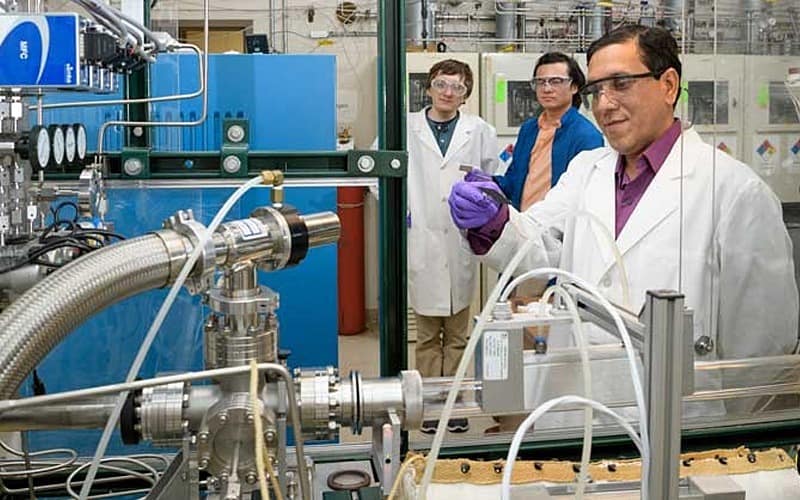 Research & Discovery
Research & Discovery
A Blog Devoted to UD Innovation, Excellence and Scholarship
Research & Discovery
A Blog Devoted to UD Innovation, Excellence and Scholarship
New grant supports research in solar energy
ABOVE: Ujjwal Das, an associate scientist at the University of Delaware’s Institute of Energy Conversion, examines a silicon wafer after a thin layer of sulfur – less than 5 nanometers thick – was deposited on the surface. In the background, doctoral students Robert Theisen and Isaac Lam watch a silicon wafer emerge from the atmospheric pressure vapor treatment reactor, where it was treated with hydrogen sulfide and hydrogen selenide gases. The reactor was developed at IEC. | Photos by Kathy F. Atkinson
UD’s Ujjwal Das and collaborators work to improve photovoltage technology
The University of Delaware has a distinctive muscle in this effort in its Institute of Energy Conversion (IEC), the oldest continuously operating solar research site in the world. IEC has experts in thin-film and crystalline silicon photovoltaic science under its roof. The ideas that emerge when those experts interact can prompt new experiments, new possibilities and new solutions.
Research scientist Ujjwal Das is one of IEC’s experts, specializing in addressing defects on the surface of silicon, defects that–if unaddressed–reduce voltage and current in silicon solar cells, the most familiar kind of solar technology for most consumers and the most frequently installed type of solar system in residential settings.
Now, Das and collaborators at Georgia Tech and the University of Nevada, Las Vegas, have won an $800,000 grant from the U.S. Department of Energy for a new approach to improving the efficiency of silicon solar cells in ways easily adapted for standard manufacturing processes.
Specifically, Das and collaborators are focused on improving the efficiency of Passivated Emitter Rear Cells (PERC cells, for short), which are silicon solar cells designed with special materials and varying textures on the rear side of the cell to improve efficiency. The word “passivation” describes the result of treatments that reduce recombination, a phenomenon that bumps electrons from their electricity-generation mode and into a lower level of activity, gouging cell performance.
Das will focus on surface passivation. UNLV’s specialty is characterizing the materials to understand how the passivation is happening. And Georgia Tech will integrate the materials into the actual cell.
PERC cells are a fast-growing sector of solar technology, especially because of a recent approach that uses aluminum oxide as the passivating material. Aluminum oxide is abundant and relatively cheap, but has not produced enough voltage, Das said. In addition, it only works well on one side of the cell.
Das and his collaborators have demonstrated a new approach – using the previously untested elements sulfur and selenium – that appears to work better. They don’t know why or how yet. The new grant will support that study and further development of the technology.





